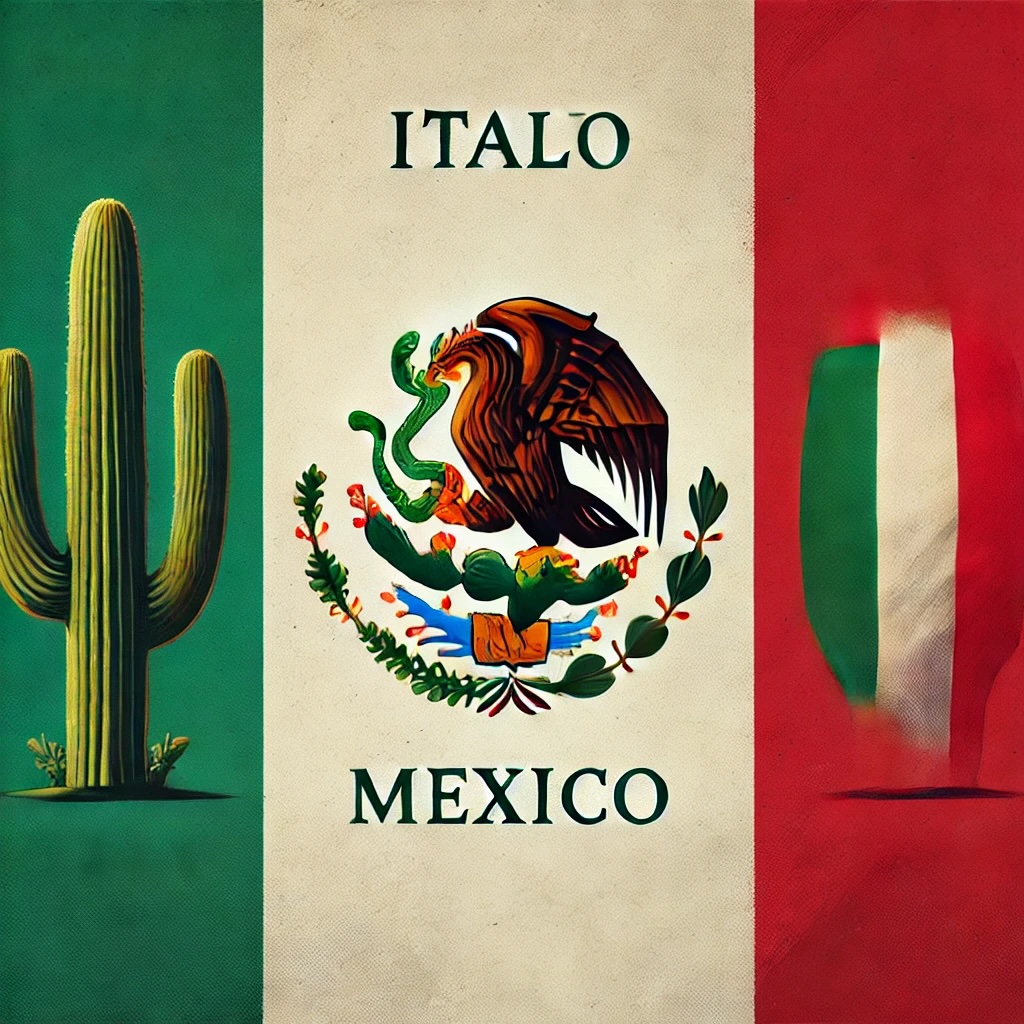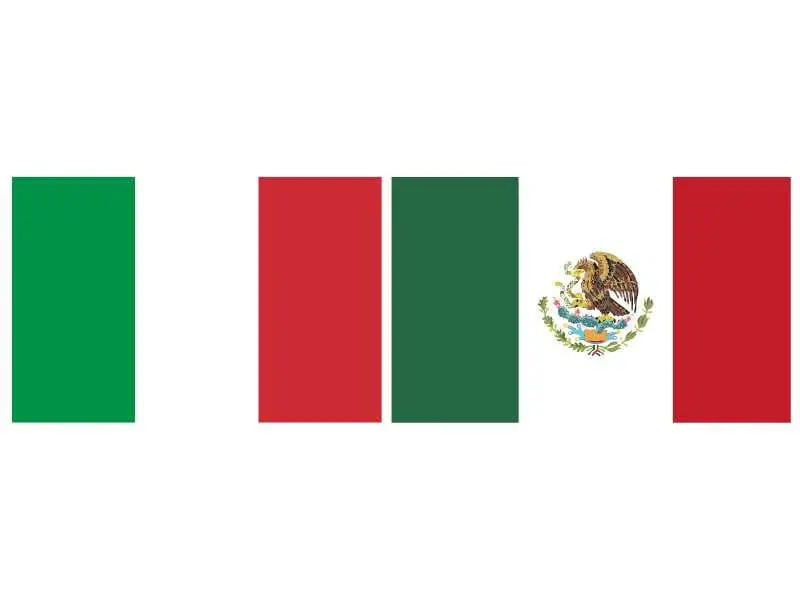The Italian and Mexican flags share green, white, and red colors that often confuse travelers who encounter these iconic symbols abroad. These flags display similar vertical tricolor stripes that can perplex even seasoned globetrotters at first sight. The emblems represent two completely different cultures, histories, and nations.
The Italian and Mexican flags use the same color palette, but key differences set these national symbols apart. Mexico’s flag displays its national coat of arms in the center white stripe, which distinguishes it from Italy’s simpler design. The flags’ proportions vary substantially – Mexico’s flag has a longer 4:7 ratio, while Italy’s flag keeps a 2:3 ratio. These national banners also emerged from different eras. Italy officially adopted its flag in 1946, though its origins trace back to the Napoleonic era in the late 18th century. Mexico adopted its current flag in 1968, with its design rooted in the country’s independence during the early 19th century.

Visual Similarities Between the Italian and Mexican Flags
A strange sense of déjà vu hits you when you stand at the border between two nations with remarkably similar flags. Many international travelers get puzzled by how much the Italian and Mexican flags look alike. These two flags share such an uncanny resemblance that people often mix them up at first glance.
Shared tricolor layout: green, white, and red
The Italian and Mexican flags display a similar color scheme – green, white, and red in vertical bands of equal width. This tricolor design creates an instant visual connection between these national symbols. The specific colors weren’t chosen by chance – they represent an aesthetic that reaches beyond continental boundaries.
Both flags follow the exact same pattern. The green sits next to the flagpole, white takes the middle spot, and red appears at the free edge. These matching colors and placement make the flags hard to tell apart when viewed from a distance.
Vertical stripe orientation
Most flags use horizontal stripes, but the Italian and Mexican flags use vertical ones instead. This unique choice of vertical design makes their similarity even more striking. These two flags stand out from others in the global community because of this distinctive feature.
The French tricolor inspired many national flags designed in the late 18th and early 19th centuries. This influence shows in part through the vertical stripes both nations chose. Very few other national symbols share such a strong visual connection.
Original confusion among viewers
The flags look so much alike that they caused real problems in various situations. The similarity became such an issue in maritime transport that both countries had to create special naval flags with different crests. The International Maritime Organization requested this change. The Mexican mercantile flag looked exactly like the Italian Republican tricolor from 1946 because it didn’t have its coat of arms.
People do double-takes when they see either flag displayed abroad. One person shared their experience: “We hung an Italian-flag windsock on our deck as a prop for an upcoming party and realized that the colors looked a lot like the Mexican flag on first glance”. Even people who know international symbols get confused, which shows just how similar these flags appear.
Many wonder if one nation borrowed the other’s design. All the same, these two flags came from different historical backgrounds and tell completely different national stories, despite looking so much alike. Their remarkable resemblance remains one of the most interesting coincidences in flag study, and it continues to surprise people who see these national symbols during their world travels.

Key Design Differences That Set Them Apart
My travels through Italy and Mexico often left me doing double-takes at what looked like similar flags waving in the breeze. These twin banners have some key differences that set them apart. Travelers between these vibrant countries should learn these differences to avoid those awkward “which country am I in again?” moments.
Presence of the Mexican coat of arms
The Mexican flag stands out from the Italian flag with its distinctive coat of arms on the white stripe. This emblem shows a golden eagle on a prickly pear cactus while it devours a rattlesnake. The design tells the story of Mexico’s Aztec heritage and points to an ancient prophecy that led to the founding of Mexico City.
The Mexican flag’s coat of arms is rich with symbolism. The eagle takes a fighting stance as it grips the snake with its talon and beak. A nopal cactus with its fruits grows from a base in water that represents Lake Texcoco. The design features oak and laurel leaves tied with a ribbon in Mexico’s national colors.
The Italian flag keeps things simple and clean, while the Mexican flag tells a deeper story through its central emblem.
Different color shades used
The flags also differ in their color intensity. Mexican flags use darker shades of green and red than Italian ones. You can spot this difference easily when both flags are next to each other.
These different shades serve a purpose – they help tell the flags apart from far away. The unique color choices also reflect each nation’s culture and history, adding another way to tell these look-alike flags apart.
Flag proportions: 2:3 vs 4:7
The most subtle difference lies in the flags’ measurements. Italian flags have a 2:3 ratio – if the width is 2 units, the length is 3 units. This creates a more compact look.
Mexican flags are longer and more rectangular with a 4:7 ratio – for every 4 units of width, there are 7 units of length. This makes the Mexican flag look more stretched out than Italy’s national symbol.
This size difference helps create each flag’s unique look. The Mexican flag appears more stretched horizontally when both flags hang at the same height.
Whether you’re walking through Rome’s ancient streets or Mexico City’s vibrant markets, knowing these differences helps you stay oriented. The coat of arms is the best way to spot a Mexican flag quickly. The color intensity and size differences offer extra clues for anyone trying to tell these national symbols apart.
Symbolism Behind Each Flag’s Colors and Elements
Each national flag carries a mixture of meanings through its colors and symbols. The flags of Italy and Mexico look similar at first glance, and their shared green, white, and red colors tell fascinating stories about each nation’s culture.
Italian flag: geography, unity, and sacrifice
Italy’s tricolore represents more than just its visual beauty. Each color symbolizes something special about the nation’s values and landscape. The green stripe shows off Italy’s rich plains and hills. It stands for hope, fertility, and the country’s natural beauty. This connection really hits home when you walk through Tuscany’s rolling hills.
The white band in the middle represents the snow-covered Alps along Italy’s northern border. It stands for faith, purity, and peace. The red band honors the blood of those who died during Italy’s fight for independence and unity.
These colors also connect to core Italian values: hope (green), faith (white), and charity (red). During my food adventures in Italy, locals would proudly tell me how these values shape Italian identity. The flag reminds them daily about their cultural roots.
Mexican flag: hope, purity, and national heroes
The Mexican flag tells its own powerful story of national identity, even though it shares colors with Italy’s flag. The green stripe first meant independence from Spain, but now it represents hope and prosperity for Mexican people. You can feel this optimism everywhere in Mexico’s bustling cities.
The white stripe shows the purity of national ideals and religious faith, highlighting Mexico’s deep Catholic roots. The red stripe remembers the national heroes who gave their lives for Mexican independence.
These colors meant something different during Mexico’s independence war through the “Three Guarantees” of Agustín de Iturbide: religion (white), independence (green), and unity between Americans and Europeans (red). This history gives the Mexican flag layers of meaning that connect past struggles to present identity.
Meaning of the Mexican coat of arms
Mexico’s stunning central emblem sets its flag apart from Italy’s. This detailed coat of arms shows an eagle sitting on a prickly pear cactus while eating a snake – an image rooted in ancient Aztec myths.
The story goes that the Aztec god Huitzilopochtli told his people to build their city where they saw an eagle on a cactus eating a snake. They found this exact scene on a tiny island in Lake Texcoco and built Tenochtitlan – now Mexico City.
Every part of the emblem means something special. The eagle represents the sun and the Aztecs’ connection to their gods. The snake shows evil being defeated. The cactus marks where Mexico City began, and the surrounding water shows Lake Texcoco. Oak and laurel leaves around the emblem stand for victory and honor.
You’ll see this emblem proudly displayed all over Mexico, from historic Oaxaca to modern Mexico City. It shows how these two flags, though similar in color, tell very different cultural stories.
Historical Origins and Evolution of Both Flags
The striking similarities and subtle differences between Italy’s and Mexico’s flags have fascinating origins. My visits to historical museums in both nations have revealed captivating stories behind these iconic banners.
Italian flag roots in the Napoleonic era
The Italian tricolor made its official debut on January 7, 1797. The Cispadane Republic, under Napoleon’s influence, formally adopted the green, white, and red flag. Deputy Giuseppe Compagnoni made this momentous decision in Reggio Emilia by proposing that “the Cispadane Standard or Flag of Three Colors, Green, White and Red shall become universal”. These colors had already appeared on military banners of the Lombard Legion in 1796.
The green color came from Milan’s Civic Guards’ uniforms (green since 1782). The white and red colors originated from Milan’s ancient municipal coat of arms. Various Italian republics adopted similar tricolor flags during the Napoleonic campaigns from 1796 to 1799. These early versions became the foundation for Italy’s national symbol. The current version became official in 1946 after the monarchy fell.
Mexican flag and the Army of the Three Guarantees
The Mexican flag’s story unfolded differently on the other side of the Atlantic. The Flag of the Three Guarantees became Mexico’s first national flag in 1821. Agustín de Iturbide created it in Iguala, and tailor José Magdaleno Ocampo brought it to life. This historic banner represented the Army of the Three Guarantees (Ejército Trigarante). Spanish troops under Iturbide united with Mexican insurgents led by Vicente Guerrero to form this army.
The flag’s colors embodied three guarantees: religion (Catholicism), independence, and unity. This army, 16,134 strong, marched triumphantly into Mexico City on September 27, 1821. Mexico declared its independence the next day. This pivotal moment cemented the tricolor pattern in Mexican national identity.
Influence of the French tricolor on both
The French tricolor served as inspiration for both flags. The French Revolution in 1790 popularized the concept of tricolor flags as national symbols rather than dynastic emblems. This idea spread throughout Europe and beyond.
Both flags developed independently yet followed similar paths. The Mexican tricolor predates modern Italy’s flag adoption. Italian kingdoms had used red-white-green schemes since the late 18th century, but Italy didn’t formally unite until the 1860s.
My culinary experiences in both countries have shown me how locals take pride in sharing these historical origins. They sometimes engage in friendly debates about which flag came first! These parallel yet distinct histories explain why two nations separated by an ocean share such similar national symbols.
Common Myths and Misconceptions About the Flags
My culinary adventures in Italy and Mexico have exposed me to many myths about their look-alike flags. While enjoying espresso in Rome or sipping mezcal in Oaxaca, locals would share their theories about the connection between Italian and Mexican flags. These stories turned into fascinating misconceptions.
Did Mexico copy Italy’s flag?
Italian trattorias often echo a common myth that Mexico just “stole” their design. The historical facts tell a different story. Both countries created their flags independently around the same time. They drew inspiration from the French tricolor instead of copying each other. The Italian flag came from Napoleonic influence, while Mexico chose its colors to represent their fight for independence.
The shared green, white, and red colors happened by chance – neither country borrowed from the other. Both nations picked colors that held meaning to their own culture and history. This shows how similar designs can emerge naturally rather than through copying.
Which flag came first?
The answer isn’t straightforward. The Italian tricolor made its official debut in 1797, making it older on paper. In spite of that, the Mexican tricolor has been used without interruption longer than its Italian counterpart.
Yes, it is worth noting that when Mexico adopted its flag, no sovereign European nation was using the Italian tricolor. Mexico designed its Trigarante flag in 1821, while modern Italy didn’t take shape until the Kingdom formed in the 1860s.
Why they look similar but aren’t the same
Of course, both flags trace their roots to the French tricolor, which explains their vertical stripes. This shared origin created their similar appearance today.
These similarities caused real problems in shipping – the original Mexican merchant flag didn’t have its coat of arms, making it look just like the Italian Republican tricolor of 1946. The International Maritime Organization asked both countries to add special naval flags with different crests to avoid mix-ups.
Beyond sharing colors, each flag tells its own story through different proportions (2:3 for Italy vs 4:7 for Mexico) and color shades (Mexico uses darker ones). Their remarkable similarity shows how nations across oceans can create such similar national symbols independently.
Summing all up
Green, white, and red – these colors link two nations across oceans and tell completely different stories. Travelers often get confused when they see the Italian and Mexican flags while walking through Rome’s ancient streets or Mexico City’s vibrant markets. A closer look shows fascinating differences that make each flag a unique cultural symbol.
You won’t find many national symbols that look so alike yet represent such different paths to independence. Both flags came about on their own during key moments in their nations’ push for unity and freedom. The Italian tricolor emerged in the Napoleonic era as a symbol of hope and unity. The Mexican banner grew from the Army of the Three Guarantees during their fight to break free from Spain.
Some people think one nation copied the other. History proves they developed side by side without copying each other. Both flags took inspiration from the French tricolor design and created their own cultural meaning for these colors.
These flags remind travelers of each nation’s identity as they move between pasta workshops in Tuscany and mezcal tastings in Oaxaca. Mexico’s coat of arms shows a magnificent eagle eating a serpent on top of a cactus – an ancient Aztec story. Italy’s simple tricolor bands reflect the Italian peninsula’s features.
New visitors might find it hard to separate these two flags from far away. Any experienced traveler should know the Mexican flag’s special features: its coat of arms, darker colors, and longer shape.
The shared colors between these flags create an interesting coincidence in world vexillology. Each flag waves proudly as proof of its nation’s path, values, and heritage. These look-alike flags show how countries separated by big oceans can create similar symbols while keeping their own identity.
Next time a green, white, and red flag catches your eye against ancient ruins or a colonial plaza, take a good look. The details will tell you if you’re about to enjoy perfect carbonara or authentic street tacos.
Here are some FAQs about Italy flag vs Mexico flag:
Why are Mexico and Italy’s flags similar?
The Italy flag vs Mexico flag similarity comes from their shared tricolor design of green, white, and red vertical stripes, which originated from the French Tricolore. The Mexico vs Italy flag difference lies in their central emblems – Mexico’s features an eagle with a snake, while Italy’s is plain. Both nations chose these colors during their respective independence movements in the 19th century.
Which flag was made first, Italy or Mexico?
The Italy flag came before the Mexico flag, with the Italian tricolor first appearing in 1797 during the Napoleonic era. The Mexico flag vs Italy flag timeline shows Mexico adopted its current design in 1821 after gaining independence from Spain. Though similar, these flags developed independently for different national purposes.
Which country has a flag similar to Italy?
Several nations have flags resembling Italy’s, with the most notable being Mexico in the Mexico vs Italy flag comparison. Other countries with similar tricolor designs include Ireland and Côte d’Ivoire, though their stripes are arranged differently. The Italy vs Mexico flag similarity remains the most striking example of this design parallel.
What country flag looks like Mexico?
Italy’s flag most closely resembles Mexico’s in the Italy flag vs Mexico comparison, both featuring vertical green, white and red stripes. The key Mexico flag vs Italy flag difference is Mexico’s national coat of arms in the center white stripe. Hungary’s flag also uses similar colors but with horizontal rather than vertical stripes.
Why does Spain have different flags?
Spain has different flags representing its various regions and historical periods, unlike the consistent Italy flag vs Mexico flag designs. The current Spanish flag dates to 1785 but has undergone modifications, particularly during political regime changes. These variations reflect Spain’s complex history and regional diversity compared to more standardized national flags.
What are the two most similar flags in the world?
The Italy vs Mexico flag pair is among the world’s most similar, differing only in the central emblem. Another remarkably similar pair is Indonesia and Monaco, both featuring identical red and white horizontal stripes. These similarities often cause confusion despite the flags representing completely different nations and histories.
Which flag came first, Italy or France?
France’s flag predates Italy’s, with the French Tricolore first appearing in 1790 during the Revolution. The Italy flag vs Mexico flag development came later, inspired by France’s revolutionary symbolism. France’s design became the model for many subsequent tricolor flags across Europe and the Americas.
When was the first Spain flag made?
The first recognizable Spanish flag appeared in the 15th century under the Catholic Monarchs, long before the Italy flag vs Mexico flag designs. The current red and yellow triband version was officially adopted in 1785 as Spain’s naval ensign. This makes Spain’s flag older than both the Italian and Mexican tricolor designs.


